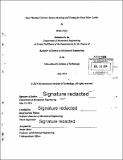Solar thermal collector system modeling and testing for novel solar cooker
Author(s)
Foley, Brian, S.B. (Brian M.). Massachusetts Institute of Technology
DownloadFull printable version (4.611Mb)
Other Contributors
Massachusetts Institute of Technology. Department of Mechanical Engineering.
Advisor
David Gordon Wilson.
Terms of use
Metadata
Show full item recordAbstract
Solar cookers are aimed at reducing pollution and desertification in the developing world. However, they are often disregarded as they do not give users the ability to cook after daylight hours. The Wilson solar cooker is a solar cooker designed to address this problem by converting solar energy and storing that energy as heat in the form of molten salt (lithium nitrate). This thesis involved research, modeling, and experimentation for the solar collection system of the cooker. This thesis looked at prior research on glazing, Fresnel lenses, and absorber surface treatments to identify and evaluate elements for use in the collection system. Borosilicate glass, with a thermal conductivity of 1.005 W/mK and a solar transmittance of 0.91, and flat black paint, with absorptivity 0.96 and emissivity 0.88 were identified as potential elements for use in first trials. Experimentation was performed on copper and aluminum samples with various surface treatments powered by various Fresnel lenses to evaluate the relative efficiency of these treatments. A novel treatment method, machining a conical hole into the sample, was found to improve efficiency on untreated samples, but inferior to flat black paint. Modeling predicted that the minimum collection area for an acrylic Fresnel lens off-number 1.2 was 0.60 m² for and 0.65 m² for the proposed collector without and with glazing, respectively. A recommendation of collection area 1 m² was proposed to account for unexpected losses due to manufacturing errors, positioning errors, and environmental variation. This thesis also analyzed a proposal for a novel solar collector, a polished aluminum cone. Modeling and efficiency testing showed the cone to be inadequate for the radiation collection needed for the solar cooker.
Description
Thesis: S.B., Massachusetts Institute of Technology, Department of Mechanical Engineering, 2014. Cataloged from PDF version of thesis. Includes bibliographical references (page 22).
Date issued
2014Department
Massachusetts Institute of Technology. Department of Mechanical EngineeringPublisher
Massachusetts Institute of Technology
Keywords
Mechanical Engineering.